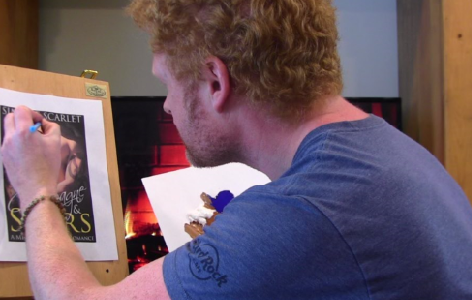Most Readers Really DO Judge a Book by it’s Cover
Hi! I’m Ginger! I recently joined Hidden Gems as a resident cover designer – the first of many that authors will be able to choose to work with by visiting the new Cover Design service page. As somebody with a vested interest in book covers, I was invited to share a few thoughts about how important a book cover can be – and how one of the first rules you learn as a child ends up being one of the first rules readers ignore!

When you’re a kid, one of the first things your parents teach you is not to judge by appearances.
“Don’t judge a book by its cover.”
Unfortunately, many of us do just that. While it’s definitely not fair, most of us make snap judgments about things based on their appearance – like you’d normally walk right past a restaurant if the front windows weren’t clean, because you ‘judge’ that if a restaurant owner isn’t diligent about cleaning a window, they’re probably not too diligent about cleaning the kitchen, either!
The most ironic thing, perhaps, is that one of the areas in which the phrase “don’t judge a book by its cover” is most ignored is in publishing itself. Any author will tell you that a cover can often make or break a book – as readers make a lot of assumptions about a book by its cover (and not all of them are unfair.)
It’s unfortunate, though – as often a cover doesn’t fairly represent the content within; and many readers miss out on awesome books because the cover didn’t immediately ‘grab’ them.
It’s something we see at Hidden Gems all the time. Some fantastic books get a lackluster reception not because they’re bad – but because the cover wasn’t ‘on point.’
As a cover designer, I’ve seen similar things – and also worked with authors who’ve seen their book soar up the sales charts when they change the cover to something more expected.
So why does a cover make such a big impact? And what can readers and authors learn from that?
Why Is a Good Cover So Important?
When it comes to the impact a cover has on the success of a book, there are two areas to consider. The first is like the dirty window in the restaurant – how the cover wordlessly demonstrates that the contents of the book might not be up to scratch.
In the era of self-publishing, a cover makes a big difference. It’s normally the first thing a potential reader sees, and in their head it makes them decide whether a title looks like it’s a professionally published book or something just slapped together haphazardly. Traditionally those professional covers were produced by ‘traditional’ publishers, but many self-published authors now produce books that have covers and quality that match or often exceed those – but not always. Sometimes newer authors don’t realize the importance of that first impression, hoping that readers will judge their book more by the content than its coating.
But a cover with a professional-looking design, standardized layout of title and author name, and other slick details demonstrates that the author ‘gets it.’ They know what’s expected by a reader, and they’ve invested the appropriate amount of time and money into making the cover look right. A fair assumption would be that if this author invested so heavily in the cover, they probably invested in the contents of the book too – like using beta readers to hammer out the plot details, and editors to give the book a final polish that provides a seamless and enjoyable reading experience.
This is, in general, a pretty safe assumption to make.
And that’s why authors who design their own covers or use a bargain-basement cover design service from somebody on Fiverr.com are often easy to spot.
Tell-tale giveaways of self-made covers are amateurish design (made using Powerpoint, or Canva, or Amazon’s own Cover Creator, instead of Photoshop) and standardized, generic fonts laid out in goofy ways. Cover design has certain conventions that most designers are aware of, but many authors aren’t – and while it might not be easy for a reader to explain the specifics of those conventions, most can tell at a glance if a book looks ‘right’ or not.
And not all design services are created equal (Fiverr or otherwise). Lower budget designers tend to make more generic-looking covers – whether because of lack of experience, or in an effort to balance the low cost of their product by making it quick and easy to produce. You’ll see things like the overuse of stock images (those ones you see over and over on so many covers) or the same out-of-the-box fonts used again and again.
Traditional publishers, and the higher-end self-published authors (who often have standards higher than those of traditional publishers) aren’t afraid to invest more heavily in their book covers. They’ll hire designers that live and breathe cover design. They use expensive photography – or at least spend more time picking less generic stock art – and they’ll have the Photoshop skills to manipulate the images to make them more unique and specific to the book – plus they’ll have specifically-purchased fonts, and stay on top of and understand the current trends.
As I said above, it’s difficult to explain exactly how you know whether a book cover is designed by a ‘pro’ or an amateur, but you just do – and so do your readers.
But don’t just take my word for it, let’s look at some real world examples.
Backing it Up – Some Real World Examples
I’ve worked with many authors who’ve changed the cover of their book – and simultaneously changed that book’s sales trajectory.
Not all authors are eager to share their horror stories of covers-gone-bad, but Simone Scarlet was willing to provide us with some examples and comparisons, along with sales data to back it up. Simone writes moderately successful bad-boy romances, and has had her share of ups and downs.
Here are two covers for the same book – and you can see the massive difference it made to the book sales.

“Bruiser isn’t exactly my best work,” Simone admits, “but it’s the best example I have of how a cover can make a huge difference to your book sales. I originally wrote the book and thought I’d design the cover myself – how hard could it be, right? And yet the book flopped on opening; and after talking with fellow authors, they identified the cover as one of the major problems.
It wasn’t that it was bad, so much – although it was! It was that the style of the cover was all wrong. The guy looked scary, not sexy. The font I chose was more thriller-style than romance. It just didn’t look like a romance book; and the sales reflected that.
A few months after publishing it, I spent a significant amount of money to buy a ‘real’ cover from a well-known cover designer, and as you can see – it’s beautiful! And it also made a huge impact on the sales. With the same title and blurb, the book made ten times as much money in much less time.”
I know $632 isn’t much to write home about, but this was one of my first romance novels, and the cover wasn’t the only thing I got wrong. The book featured cheating – a big ‘no-no.’ There was a love triangle, but between a guy and two girls – another ‘no-no.’ It wasn’t a bad story – in fact, it’s so personal to me that it remains one of my favorite books. But it’s interesting to see how even a deeply flawed book can still get ten times as many sales with a new cover.”
Simone worked with that cover designer on three more novels, and because she managed to get the rest of the romance elements right, they went on to each make significantly more money.
And listen, I didn’t just take another author’s word for it – just like the “Hair Club for Men” I’m also a customer. I learned first-hand the difference a cover can make.
Back before I started designing covers myself, I wrote a bonkers spy novel called The Atomic Eight Inches. Not going to lie – James Patterson had nothing to worry about. Still, my book launch was disappointing at first – until I realized my mistake and switched things up. You can see what a difference a professionally produced cover made below.
I was pretty proud of the original cover I designed – but, of course, that was before I knew anything about cover design. When my book tanked, a friend who’d loved reading it suggested I pay for a professional cover. He didn’t steer me wrong. I got an old agency buddy to design a new cover and the sales figures speak for themselves. That’s why I hired the same cover designer for the follow-up, which blew sales of the original out of the water (but as you can tell, I’m still not at James Patterson level… yet.)

The experience was actually why I invested in Photoshop courses and spent months learning from professional cover designers. I decided that rather than invest in a new cover each time, I’d invest in the ability to do it myself. That way, in addition to ‘eating my own dogfood’ I’d be able to offer my services to other authors. It was the start of a really exciting journey – and I get as much enjoyment and fulfillment from it as writing itself.
What Should You Do for Your Cover?
Many authors take a look at the best-seller lists and begin to craft their covers to match – following the conventions that make other authors successful and following their path. This can be a very rewarding route to take – but obviously the downside to imitation is that you’re always tugging at another author’s coattails.
Other authors boldly strike their own path – bucking convention and going with the covers that they wanted in the first place. Sometimes this approach is successful – leading to them pioneering new niches within their chosen genre and picking up a loyal following of fans who appreciate their uniqueness. However, more commonly it results in lackluster sales and a much harder route towards publishing success.
Rarer still are the authors who manage to balance both – crafting book covers that meet the conventions of a genre, but also stretching the boundaries of them. But it’s not exactly an easy skill to master, and those authors who do manage to walk that tightrope generally deserve to be on the best-seller lists.
What you choose to do for your book really depends on a various of factors and which route you choose to take – either designing your own, or hiring someone to do it for you.
Design Your Own
Designing your own cover depends on your technical design ability and knowledge of composition and trends.
What I’ve discovered over the years is that you can’t learn it overnight. Sure, you can learn the mechanics of Photoshop very quickly, but it takes months or years to just ‘get’ what looks right on a book cover. As I mentioned above, it’s not always so easy to explain what looks ‘right’ about a given cover – but even if they can’t explain it in words, readers know it when they see it; and it influences their buying decision.
Hiring a Designer
If you choose to buy a cover, who you hire depends on your budget and how important you think a cover is (a question I’ve hopefully helped answer in this article) – not to mention what you think of that designer’s previous work (their portfolio).
Their previous work is an important thing to look at. For example, as I mentioned above, one of the issues these days is how many covers look the same because of overuse of the same limited cover stock that designers have to choose from. To combat this, what I do is try and mix and merge different stock art to create something new – so you don’t always find the same guy on the same genre of books (if we’re using Romance as an example). Take a look at a cover I’m designing for Simone Scarlet below, and you’ll see what I mean:

For authors, the most important takeaway here is that you shouldn’t underestimate the importance of your cover, despite the ideal that readers should be paying far more attention to the contents of the book. After all, it’s what’s inside that counts. Right?
For readers, the next time browsing for a new book, consider taking an additional moment to check the “Look Inside” section and even read some of the reviews. If you do, maybe you’ll find something you may ordinarily have glossed over because of a cover that doesn’t do justice to the value of the words inside. You never know – you might just find a true Hidden Gem!












And who is the original model? Is he not offended that you use another model to make someone new?